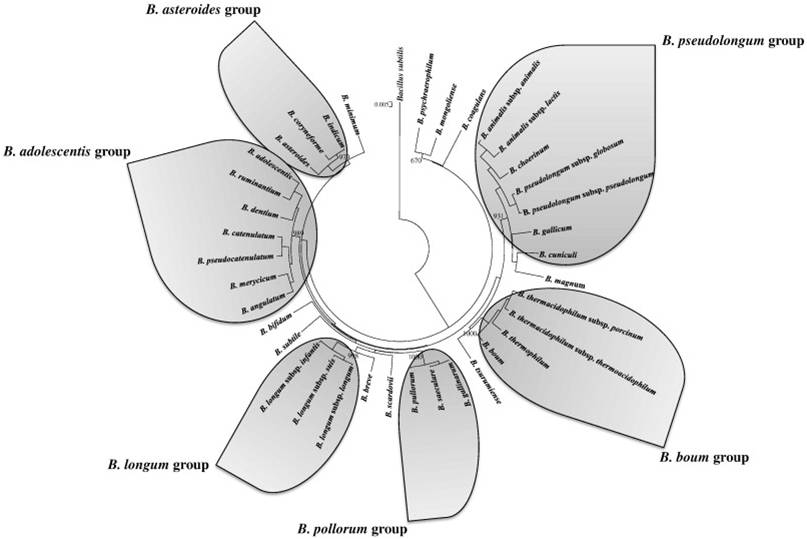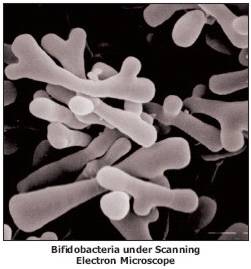Bifidobacterium choerinum: Difference between revisions
| Line 64: | Line 64: | ||
4) Matsuki, Takahiro., Watanabe, Koichi., Fukuda, Masafumi., and Oyaizu, Hiroshi. (1999) <B>Distribution of Bifidobacterial Species in Human Intestinal Microflora Examined with 16S rRNA-Gene-Targeted Species-Specific Primers</B> Applied and Environmental Microbiology. 65:10, 4506-4512; http://www.ncbi.nlm.nih.gov/pmc/articles/PMC91600/ 25, April 2013. | 4) Matsuki, Takahiro., Watanabe, Koichi., Fukuda, Masafumi., and Oyaizu, Hiroshi. (1999) <B>Distribution of Bifidobacterial Species in Human Intestinal Microflora Examined with 16S rRNA-Gene-Targeted Species-Specific Primers</B> Applied and Environmental Microbiology. 65:10, 4506-4512; http://www.ncbi.nlm.nih.gov/pmc/articles/PMC91600/ 25, April 2013. | ||
5) Scardovi V. Genus Bifidobacterium Orla-Jensen, 1924, 472. In: Krieg N R, Holt J G, editors; Krieg N R, Holt J G, editors. Bergey’s manual of systematic bacteriology. Vol. 1. Baltimore, Md: The Williams & Wilkins Co.; 1984. pp. 1418–1434. | |||
Revision as of 16:06, 25 April 2013
A Microbial Biorealm page on Bifidobacterium choerinum
Classification
Higher Order Taxa
Bacteria; Actinobacteria; Actinobacteridae; Bifidobacteriales; Bifidobacteriaceae; Bifidobacterium choerinum
Species
Species of the Genus Bifidobacterium include: B. adolescentis;B. angulatum;B. animalis; B. asteroids; B. bifidum; B. boum;B. breve;B. catenulatum; B. choerinum; B. coryneforme;B. cuniculi;B. denticolens; B. dentium; B. gallicum; B. gallinarum; B. indicum;B. infantis;B. inopinatum;B. lactis;B. longum;B. magnum;B. merycicum;B. minimum;B. pseudocatenulatum;B. pseudolongum;B. pullorum;B. ruminantium; B. saeculare; B. subtile; B. suis;B. thermacidophilum;B. thermophilum.
Description and Significance
Bifidobacterium choerinum is an autochthonous bifidobacterium species of the pig that is well adapted to the gut of pre-weaned piglets and shows potential probiotic properties (2).
Bifidobacterium choerinum is part of the B. pseudolongum group which is a branch of the Actinobacteria.
Genome Structure
Bifidobacterium chromosomes are circular shape. ? bp in length with a 50% G-C content.
The particular species of Bifidobacterium can be easily detected by using the species-specific PCR method for identifying Bifidobacterium strains isolated from human feces (4).
Cell and Colony Structure
Bifidobacteria choerinum is a Gram-positive, anaerobic, branched rod-shaped bacterium. This particular type of bacteria are non-sporing and also non-motile. It is 10-12 μm and has a V or Y-like appearance. The optimal temperature for growth is 37-41°C and a pH of 6.5-7.3. This bacterium has a hydrophobic character of bifidobacterium surface (3). Bifidobacterium accumulate iron when it is presented in the ferrous oxidation state. This form is expected under anaerobic conditions like the human colon or cattle rumen (3).
Metabolism
Bifidobacterium have been known to synthesize vitamins. It is an anaerobic microbe best grown in a TSA slant at 37°C. Significant amounts of polysaccharides normally galactose and glucose often associated with rhamnose (3). This bacterium is not considered to reduce nitrate (3). It also will not develop in the presence of CO2. When residing in the intestines, they are able to ferment sugars to produce lactic acid. It has also been shown to be resistant to aminoglycoside antibiotics while being susceptible to Beta-lactams (3).
This type of bacterium ferments glucose via the phosphoketolase pathway and not via glycolysis. The typical fermentation end products are acetate and lactate.
Ecology
This bacterium is ubiquitous, endosymbiotic inhabitant.
Pathology
Bifidobacterium choerinum are non-pathogenic.
Current Research
References
1) Euzeby, J.P. List of Prokaryotic Names with Standing in Nomenclature- Genus Bifidobacterium. 12 March 2013. http://www.bacterio.cict.fr/b/bifidobacterium.html
2) Maxwell FJ., Duncan SH., Hold G., Stewart CS. Isolation, Growth on Prebiotics and Probiotic Potential of Novel Bifidobacteria from Pigs. Anaerobe. (2004) Online.
3) Whitman, William B., Goodfellow, Micahel., Kampfer, Peter., et. (2012) Bergey's Manual of Systematic Bacteriology. Vol. 5.
4) Matsuki, Takahiro., Watanabe, Koichi., Fukuda, Masafumi., and Oyaizu, Hiroshi. (1999) Distribution of Bifidobacterial Species in Human Intestinal Microflora Examined with 16S rRNA-Gene-Targeted Species-Specific Primers Applied and Environmental Microbiology. 65:10, 4506-4512; http://www.ncbi.nlm.nih.gov/pmc/articles/PMC91600/ 25, April 2013.
5) Scardovi V. Genus Bifidobacterium Orla-Jensen, 1924, 472. In: Krieg N R, Holt J G, editors; Krieg N R, Holt J G, editors. Bergey’s manual of systematic bacteriology. Vol. 1. Baltimore, Md: The Williams & Wilkins Co.; 1984. pp. 1418–1434.


